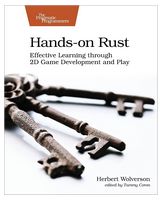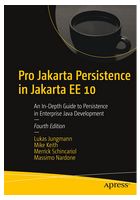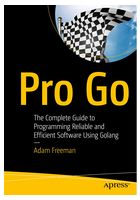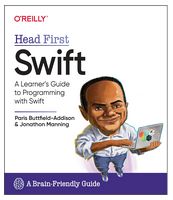Scala Cookbook Recipes for Object-Oriented and Functional Programming 13642
-
ISBN
-
Видавництво
-
Автор
-
МоваАнглійська
Все про “Scala Cookbook Recipes for Object-Oriented and Functional Programming”
Від видавця
Зміст
Chapter 1 : Strings
Introduction
Testing String Equality
Creating Multiline Strings
Splitting Strings
Substituting Variables into Strings
Processing a String One Character at a Time
Finding Patterns in Strings
Replacing Patterns in Strings
Extracting Parts of a String That Match Patterns
Accessing a Character in a String
Add Your Own Methods to the String Class
Chapter 2 : Numbers
Introduction
Parsing a Number from a String
Converting Between Numeric Types (Casting)
Overriding the Default Numeric Type
Replacements for ++ and ??
Comparing Floating-Point Numbers
Handling Very Large Numbers
Generating Random Numbers
Creating a Range, List, or Array of Numbers
Formatting Numbers and Currency
Chapter 3 : Control Structures
Introduction
Looping with for and foreach
Using for Loops with Multiple Counters
Using a for Loop with Embedded if Statements (Guards)
Creating a for Comprehension (for/yield Combination)
Implementing break and continue
Using the if Construct Like a Ternary Operator
Using a Match Expression Like a switch Statement
Matching Multiple Conditions with One Case Statement
Assigning the Result of a Match Expression to a Variable
Accessing the Value of the Default Case in a Match Expression
Using Pattern Matching in Match Expressions
Using Case Classes in Match Expressions
Adding if Expressions (Guards) to Case Statements
Using a Match Expression Instead of isInstanceOf
Working with a List in a Match Expression
Matching One or More Exceptions with try/catch
Declaring a Variable Before Using It in a try/catch/finally Block
Creating Your Own Control Structures
Chapter 4 : Classes and Properties
Introduction
Creating a Primary Constructor
Controlling the Visibility of Constructor Fields
Defining Auxiliary Constructors
Defining a Private Primary Constructor
Providing Default Values for Constructor Parameters
Overriding Default Accessors and Mutators
Preventing Getter and Setter Methods from Being Generated
Assigning a Field to a Block or Function
Setting Uninitialized var Field Types
Handling Constructor Parameters When Extending a Class
Calling a Superclass Constructor
When to Use an Abstract Class
Defining Properties in an Abstract Base Class (or Trait)
Generating Boilerplate Code with Case Classes
Defining an equals Method (Object Equality)
Creating Inner Classes
Chapter 5 : Methods
Introduction
Controlling Method Scope
Calling a Method on a Superclass
Setting Default Values for Method Parameters
Using Parameter Names When Calling a Method
Defining a Method That Returns Multiple Items (Tuples)
Forcing Callers to Leave Parentheses off Accessor Methods
Creating Methods That Take Variable-Argument Fields
Declaring That a Method Can Throw an Exception
Supporting a Fluent Style of Programming
Chapter 6 : Objects
Introduction
Object Casting
The Scala Equivalent of Java’s .class
Determining the Class of an Object
Launching an Application with an Object
Creating Singletons with object
Creating Static Members with Companion Objects
Putting Common Code in Package Objects
Creating Object Instances Without Using the new Keyword
Implement the Factory Method in Scala with apply
Chapter 7 : Packaging and Imports
Introduction
Packaging with the Curly Braces Style Notation
Importing One or More Members
Renaming Members on Import
Hiding a Class During the Import Process
Using Static Imports
Using Import Statements Anywhere
Chapter 8 : Traits
Introduction
Using a Trait as an Interface
Using Abstract and Concrete Fields in Traits
Using a Trait Like an Abstract Class
Using Traits as Simple Mixins
Limiting Which Classes Can Use a Trait by Inheritance
Marking Traits So They Can Only Be Used by Subclasses of a Certain Type
Ensuring a Trait Can Only Be Added to a Type That Has a Specific Method
Adding a Trait to an Object Instance
Extending a Java Interface Like a Trait
Chapter 9 : Functional Programming
Introduction
Using Function Literals (Anonymous Functions)
Using Functions as Variables
Defining a Method That Accepts a Simple Function Parameter
More Complex Functions
Using Closures
Using Partially Applied Functions
Creating a Function That Returns a Function
Creating Partial Functions
A Real-World Example
Chapter 10 : Collections
Introduction
Understanding the Collections Hierarchy
Choosing a Collection Class
Choosing a Collection Method to Solve a Problem
Understanding the Performance of Collections
Declaring a Type When Creating a Collection
Understanding Mutable Variables with Immutable Collections
Make Vector Your “Go To” Immutable Sequence
Make ArrayBuffer Your “Go To” Mutable Sequence
Looping over a Collection with foreach
Looping over a Collection with a for Loop
Using zipWithIndex or zip to Create Loop Counters
Using Iterators
Transforming One Collection to Another with for/yield
Transforming One Collection to Another with map
Flattening a List of Lists with flatten
Combining map and flatten with flatMap
Using filter to Filter a Collection
Extracting a Sequence of Elements from a Collection
Splitting Sequences into Subsets (groupBy, partition, etc.)
Walking Through a Collection with the reduce and fold Methods
Extracting Unique Elements from a Sequence
Merging Sequential Collections
Merging Two Sequential Collections into Pairs with zip
Creating a Lazy View on a Collection
Populating a Collection with a Range
Creating and Using Enumerations
Tuples, for When You Just Need a Bag of Things
Sorting a Collection
Converting a Collection to a String with mkString
Chapter 11 : List, Array, Map, Set (and More)
Introduction
Different Ways to Create and Populate a List
Creating a Mutable List
Adding Elements to a List
Deleting Elements from a List (or ListBuffer)
Merging (Concatenating) Lists
Using Stream, a Lazy Version of a List
Different Ways to Create and Update an Array
Creating an Array Whose Size Can Change (ArrayBuffer)
Deleting Array and ArrayBuffer Elements
Sorting Arrays
Creating Multidimensional Arrays
Creating Maps
Choosing a Map Implementation
Adding, Updating, and Removing Elements with a Mutable Map
Adding, Updating, and Removing Elements with Immutable Maps
Accessing Map Values
Traversing a Map
Getting the Keys or Values from a Map
Reversing Keys and Values
Testing for the Existence of a Key or Value in a Map
Filtering a Map
Sorting an Existing Map by Key or Value
Finding the Largest Key or Value in a Map
Adding Elements to a Set
Deleting Elements from Sets
Using Sortable Sets
Using a Queue
Using a Stack
Using a Range
Chapter 12 : Files and Processes
Introduction
How to Open and Read a Text File
Writing Text Files
Reading and Writing Binary Files
How to Process Every Character in a Text File
How to Process a CSV File
Pretending that a String Is a File
Using Serialization
Listing Files in a Directory
Listing Subdirectories Beneath a Directory
Executing External Commands
Executing External Commands and Using STDOUT
Handling STDOUT and STDERR for External Commands
Building a Pipeline of Commands
Redirecting the STDOUT and STDIN of External Commands
Using AND (&&) and OR (||) with Processes
Handling Wildcard Characters in External Commands
How to Run a Process in a Different Directory
Setting Environment Variables When Running Commands
An Index of Methods to Execute External Commands
Chapter 13 : Actors and Concurrency
Introduction
Getting Started with a Simple Actor
Creating an Actor Whose Class Constructor Requires Arguments
How to Communicate Between Actors
Understanding the Methods in the Akka Actor Lifecycle
Starting an Actor
Stopping Actors
Shutting Down the Akka Actor System
Monitoring the Death of an Actor with watch
Simple Concurrency with Futures
Sending a Message to an Actor and Waiting for a Reply
Switching Between Different States with become
Using Parallel Collections
Chapter 14 : Command-Line Tasks
Introduction
Getting Started with the Scala REPL
Pasting and Loading Blocks of Code into the REPL
Adding JAR Files and Classes to the REPL Classpath
Running a Shell Command from the REPL
Compiling with scalac and Running with scala
Disassembling and Decompiling Scala Code
Finding Scala Libraries
Generating Documentation with scaladoc
Faster Command-Line Compiling with fsc
Using Scala as a Scripting Language
Accessing Command-Line Arguments from a Script
Prompting for Input from a Scala Shell Script
Make Your Scala Scripts Run Faster
Chapter 15 : Web Services
Introduction
Creating a JSON String from a Scala Object
Creating a JSON String from Classes That Have Collections
Creating a Simple Scala Object from a JSON String
Parsing JSON Data into an Array of Objects
Creating Web Services with Scalatra
Replacing XML Servlet Mappings with Scalatra Mounts
Accessing Scalatra Web Service GET Parameters
Accessing POST Request Data with Scalatra
Creating a Simple GET Request Client
Sending JSON Data to a POST URL
Getting URL Headers
Setting URL Headers When Sending a Request
Creating a GET Request Web Service with the Play Framework
POSTing JSON Data to a Play Framework Web Service
Chapter 16 : Databases and Persistence
Introduction
Connecting to MySQL with JDBC
Connecting to a Database with the Spring Framework
Connecting to MongoDB and Inserting Data
Inserting Documents into MongoDB with insert, save, or +=
Searching a MongoDB Collection
Updating Documents in a MongoDB Collection
Accessing the MongoDB Document ID Field
Deleting Documents in a MongoDB Collection
A Quick Look at Slick
Chapter 17 : Interacting with Java
Introduction
Going to and from Java Collections
Add Exception Annotations to Scala Methods to Work with Java
Using @SerialVersionUID and Other Annotations
Using the Spring Framework
Annotating varargs Methods
When Java Code Requires JavaBeans
Wrapping Traits with Implementations
Chapter 18 : The Simple Build Tool (SBT)
Introduction
Creating a Project Directory Structure for SBT
Compiling, Running, and Packaging a Scala Project with SBT
Running Tests with SBT and ScalaTest
Managing Dependencies with SBT
Controlling Which Version of a Managed Dependency Is Used
Creating a Project with Subprojects
Using SBT with Eclipse
Generating Project API Documentation
Specifying a Main Class to Run
Using GitHub Projects as Project Dependencies
Telling SBT How to Find a Repository (Working with Resolvers)
Resolving Problems by Getting an SBT Stack Trace
Setting the SBT Log Level
Deploying a Single, Executable JAR File
Publishing Your Library
Using Build.scala Instead of build.sbt
Using a Maven Repository Library with SBT
Building a Scala Project with Ant
Chapter 19 : Types
Introduction
Creating Classes That Use Generic Types
Creating a Method That Takes a Simple Generic Type
Using Duck Typing (Structural Types)
Make Mutable Collections Invariant
Make Immutable Collections Covariant
Create a Collection Whose Elements Are All of Some Base Type
Selectively Adding New Behavior to a Closed Model
Building Functionality with Types
Chapter 20 : Idioms
Introduction
Create Methods with No Side Effects (Pure Functions)
Prefer Immutable Objects
Think “Expression-Oriented Programming”
Use Match Expressions and Pattern Matching
Eliminate null Values from Your Code
Using the Option/Some/None Pattern
Colophon
Всі характеристики
- Видавництво
- Автор
- Категорія
- Сторінок722
- Формат145х215 мм
- МоваАнглійська
- Термін поставки7-10 дней
Товар входить до категорії
-
Самовивіз з відділень поштових операторів від
45 ₴ -80 ₴ -
Доставка поштовими сервісами - тарифи перевізника












Рецензії